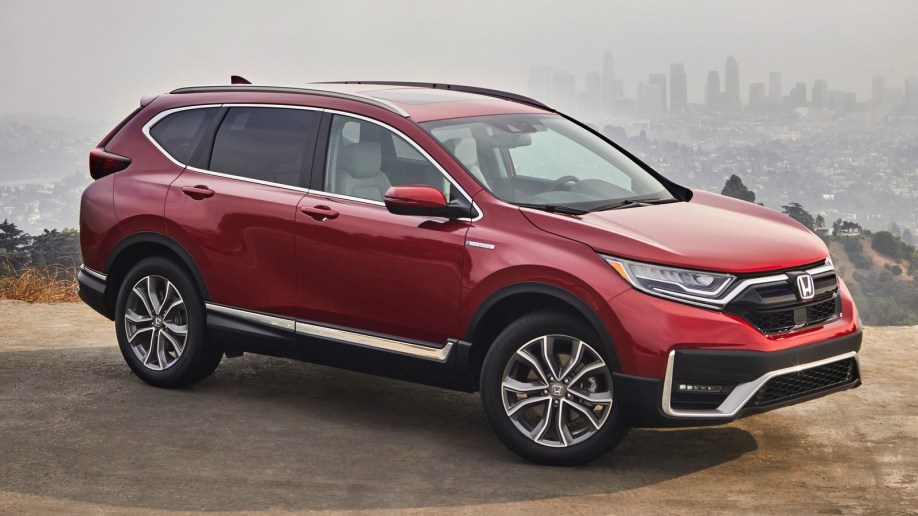Both the Honda CR-V Hybrid and Mitsubishi Outlander PHEV offer alternative options to gas engines, just in slightly different ways. Find out which one suits your needs better.
2020 Honda CR-V Hybrid
2020 Honda CR-V Hybrid Starting Price: $28,970 | Price Yours or View listings near you
Above Average: Excellent value; heated front seats standard; decent power for a compact crossover.
Below Average: Limited tow rating; AWD is for snow or mud, not a true off-roader.
Consensus: Always a rock-solid choice among compact crossovers, the Honda CR-V only continues to improve for 2020, including a hybrid model, a suite of driver assists, and Honda’s usual reputation for quality.
2020 Mitsubishi Outlander PHEV
2020 Mitsubishi Outlander PHEV Starting Price: $37,200 | Price Yours or View listings near you
Above Average: Outstanding standard warranty; great gas mileage thanks to the plug-in hybrid motor; excellent crash-test scores.
Below Average: Doesn’t look unique; not many dealers; no onboard navigation package.
Consensus: An uncommon crossover, mostly because it’s tough to find one. Its exterior feels dated, but the plug-in powertrain makes for far fewer visits to the gas pump. It gets a decent CVT but lacks luster on the road.
CR-V Hybrid vs. Outlander PHEV: Plug-in or just go?
Honda CR-V Hybrid
The CR-V is a big seller for Honda thanks to its reliability, quality, and excellent price. For 2020 this compact crossover gets some improvements. That includes standard Honda Sensing, Honda’s extensive suite of safety features. More importantly, though, might be the CR-V Hybrid powertrain. An electric motor pairs with Honda’s 2.0-liter I-4. Both are powered by a continuously variable transmission. Total output is 212 hp, over 20 hp more than the standard CR-V. That’s solid output for a vehicle in its class for the price. The CR-V Hybrid gets a 40/35/38 mpg city/highway/combined rating from the EPA, an improvement over the non-hybrid CR-V’s 27/32/29 mpg rating. The Honda CR-V makes excellent use of its interior space with lots of cubbies and pockets. Buyers can still expect space for five, a quiet and comfortable road ride, and an all-wheel-drive system with the hybrid that handles snow and mud with aplomb.
Mitsubishi Outlander PHEV
Overall, the Mitsubishi Outlander PHEV doesn’t turn heads in the looks department. The only place you will be wowed is with its 74 MPGe rating thanks to its plug-in hybrid motor. It gets a new adjustable driver’s seat, making the driving experience more pleasant. The Outlander PHEV only seats five. Blind-spot monitoring, rain-sensing wipers, and push-button start are all pleasant surprises on a base model car. There’s no nav option, Mitsubishi relies on Apple CarPlay for that feature. Two engines are available on the standard Outlander, including an I4 with 166-horsepower or a gutsier 224-horsepower 3.0-liter V6. The PHEV runs a 2.0-liter 4-cylinder engine and twin motors for a combined 190 horses. The electric range tops out at 22 miles. It takes about eight hours to charge with a standard 120-volt outlet. Cargo space feels plentiful and the interior is understated but handsome.
Similarities
Solid hybrid fuel economy. Top-notch safety ratings and features. Simple exterior and interior design language.
2020 Honda CR-V Hybrid Advantages
Higher resale value. Lower starting price.
2020 Mitsubishi Outlander PHEV Advantages
Can run on pure EV power. Better MPG than the CR-V thanks to that plug-in feature.
Final Recommendation
There’s a strong argument for the Outlander PHEV here. If you do most of your work close to home you might rarely end up at the gas pump. That is provided you have the capability to charge. The CR-V definitely has Honda’s reliability on its side. A Mitsubishi dealer and perhaps the service department isn’t easy to come by. The Outlander gets more expensive, but you’ll spend less at the pump. The CR-V has far superior resale value when it’s time to sell. The CR-V wins out here, if only for ease of use.
| 2020 Honda CR-V Hybrid | 2020 Mitsubishi Outlander PHEV | |
| Popular Powertrains | ||
| Engine | 2.0-liter I4 hybrid | 2.0L 4-cyl PHEV |
| Horsepower | 212 hp @ 6,200 rpm | 190 hp |
| Torque | 232 lb-ft @ 2,000 rpm | 137 lb-ft @ 4,500 |
| Transmission | Single-speed direct drive | CVT |
| Fuel Economy | 38 mpg (40 city/35 hwy) | 25 mpg/74 MPGe |
| Also Available | ||
| Specs | ||
| Warranty | 3 years/36,000 miles | 5 years/60,000 |
| NHTSA Overall Safety Rating | 5 stars | 5 stars |
| Max Seating Capacity | 5 | 5 |
| Wheelbase | 104.7 inches | 105.1 inches |
| Overall Length | 182.1 inches | 184.4 inches |
| Width | 73.0 inches | 70.9 inches |
| Height | 66.5 inches | 67.3 inches |
| Turning Diameter | 37.4 feet | 35.6 feet |
| Headroom, Front | 40.1 inches | 40.6 inches |
| Headroom, Rear | 39.2 inches | 38.3 inches |
| Legroom, Front | 41.3 inches | 40.9 inches |
| Legroom, Rear | 40.4 inches | 37.9 inches |
| Shoulder Room, Front | 57.9 inches | 56.4 inches |
| Shoulder Room, Rear | 55.6 inches | 56.0 inches |
| EPA Passenger Volume | 105.9 cu. ft. | 102.1 cu. ft. |
| EPA Cargo Volume | 33.2/68.7 cu. ft. | 30.4/66.6 cu. ft. |









